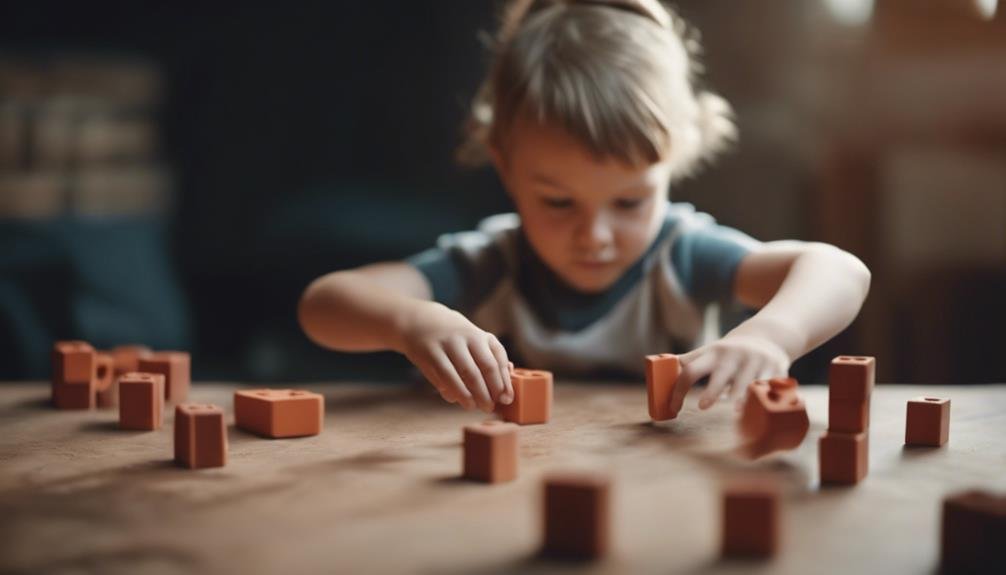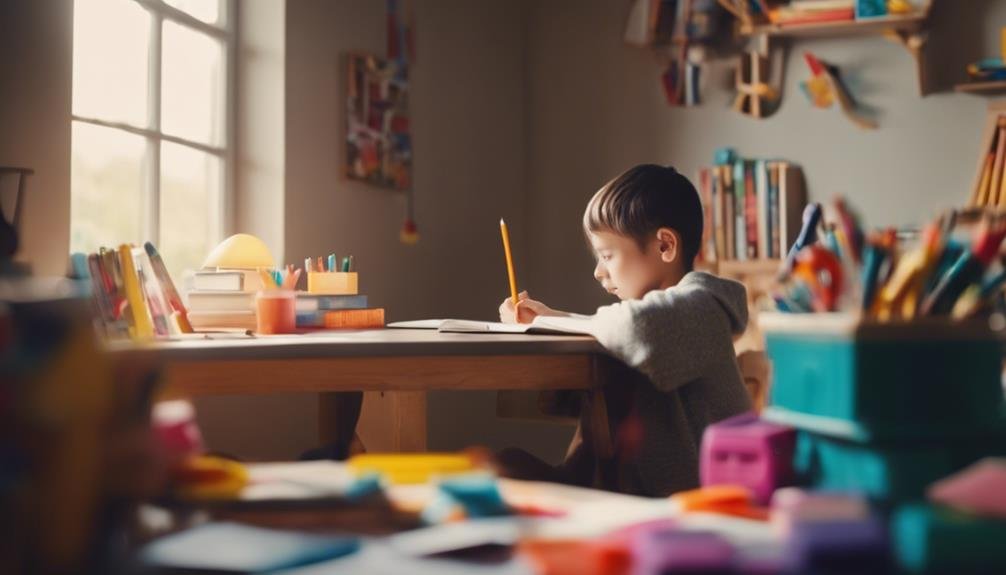"Cherishing Little Steps - A Haven for Baby and Family Journeys"
Understanding Your Child's Learning Style: A Guide for Parents
You may think that understanding your child's learning style is a complex task, but it doesn't have to be overwhelming.
By recognizing and adapting to how your child learns best, you can reveal their full potential in academic and personal growth. Discovering the unique way your child processes information can lead to more effective communication and improved performance in various aspects of their life.
Understanding these individual preferences will not only benefit their education but also enhance your relationship with them.
Key Takeaways
- Tailor educational approaches to meet diverse student needs.
- Identify your child's learning style through observation and collaboration.
- Support visual, auditory, or kinesthetic learners with tailored strategies.
- Enhance academic success by engaging with and accommodating your child's learning preferences.
Importance of Learning Styles

Understanding the importance of learning styles is essential for tailoring educational approaches to meet the diverse needs of students. Parental involvement plays a critical role in fostering student success by recognizing and accommodating different learning preferences. Research indicates that when parents engage with their child's learning style, academic performance tends to improve greatly. By understanding how your child learns best, you can provide them with the support and resources necessary to excel in their educational journey.
Studies have shown that when parents actively participate in identifying and adapting to their child's learning style, students are more likely to experience success in school. Recognizing the impact of learning preferences on academic performance empowers parents to advocate for tailored educational strategies that cater to their child's individual needs. Parental involvement in understanding and addressing learning styles is a key factor in enhancing student achievement and fostering a positive learning environment.
Identifying Your Child's Style
To effectively identify your child's learning style, observe their behaviors and responses to different learning activities. Parental involvement is key in this process. Pay close attention to how your child engages with various tasks. Do they prefer hands-on activities, or do they excel in listening and verbal instruction? These observations can provide valuable insights into their preferred learning style.
Assessment methods can also help in identifying your child's learning style. Some common assessment tools include questionnaires, interviews, and observations. These methods can offer thorough ways to gather information about how your child learns best.
As a parent, it's important to be actively involved in this assessment process. By working closely with teachers and educational professionals, you can gain a more detailed understanding of your child's learning preferences. This collaboration can lead to tailored educational strategies that cater to your child's specific needs.
Visual Learners: Characteristics and Tips

Identifying the characteristics of visual learners can provide valuable insights for tailoring educational strategies to meet their specific needs effectively. Visual learners typically excel in understanding information through visual aids such as graphs, charts, and diagrams. They have a keen eye for detail, often prefer color-coded notes, and benefit greatly from videos and illustrations. As a parent, recognizing these traits in your child can guide you in supporting their learning journey more effectively.
To help you better understand visual learners, here is a table summarizing their characteristics and some tips for parental involvement:
| Characteristic | Description |
|---|---|
| Strong visual memory | Retains information better through visual cues and images. |
| Prefers visual aids | Learns best through diagrams, charts, videos, and color-coded notes. |
| Excellent attention to detail | Notices small details that others may overlook. |
| Benefits from illustrations | Understands concepts better when explained with visual representations. |
| Enjoys creating visual materials | Likes drawing, designing, and using visual elements in projects and assignments. |
Understanding these traits can assist you in providing study aids that cater to your visual learner's preferences and enhancing parent involvement in their educational journey.
Auditory Learners: Characteristics and Tips
Exploring the auditory preferences of learners provides valuable insights for tailoring educational approaches to effectively support their learning process. Auditory learners are individuals who prefer auditory input and remember information best when they hear it.
Here are some characteristics and tips to help you understand and support your auditory learner:
- Study Habits:
Auditory learners benefit from reading aloud, listening to audiobooks, and discussing topics verbally. Encourage them to record lectures or lessons to listen to later.
- Parental Support:
Engage in conversations with your auditory learner, ask them to explain concepts out loud, and provide opportunities for them to participate in group discussions or debates.
- Auditory Processing:
These learners may struggle with written instructions but excel in following verbal directions. Encourage them to repeat information to reinforce learning.
- Memory Techniques:
Encourage the use of mnemonic devices, songs, or rhymes to help auditory learners remember information effectively. Encourage them to study in quiet environments to minimize distractions.
Understanding and accommodating your child's auditory learning style can significantly enhance their educational experience and academic performance.
Kinesthetic Learners: Characteristics and Tips

Understanding the learning preferences of kinesthetic learners offers valuable insights into tailoring educational strategies to effectively support their learning journey. Kinesthetic learners thrive on hands-on learning and active engagement. They learn best through movement-based activities and practical applications that allow them to physically interact with the material.
Characterized by a need for physical experiences, kinesthetic learners excel when given the opportunity to manipulate objects, participate in experiments, or engage in role-playing exercises. To cater to their learning style, incorporating activities that involve gestures, simulations, or real-world examples can greatly enhance their understanding and retention of information. Providing opportunities for them to build, create, or explore can also foster a deeper connection to the subject matter.
Tips for parents of kinesthetic learners include encouraging them to take frequent breaks during study sessions to move around, incorporating physical movement into learning activities, and utilizing tools such as flashcards or educational games that involve physical interaction. By recognizing and accommodating their preference for hands-on experiences, parents can effectively support their kinesthetic learners in achieving academic success.
Tailoring Study Techniques
Tailoring study techniques to accommodate your child's preferred learning style can greatly enhance their academic performance and overall learning experience. By adopting personalized strategies tailored to your child's individualized approach, you can help create an environment that fosters effective learning.
Here are some key points to take into account:
- Understanding Study Habits: Identify how your child best retains information – whether through visual aids, hands-on activities, or auditory methods. This understanding can guide you in tailoring study techniques to match their learning style.
- Embracing an Individualized Approach: Recognize that each child learns differently, and what works for one may not work for another. Embrace this individuality and tailor study techniques accordingly.
- Implementing Personalized Strategies: Utilize the information gathered about your child's learning style to create personalized study plans that cater to their strengths and preferences.
- Fostering Effective Learning: By customizing study techniques to align with your child's learning style, you can help them absorb information more effectively, leading to improved academic performance.
Creating a Supportive Environment

To cultivate an environment conducive to your child's learning, consider the impact of the physical space and emotional support provided. Parent involvement plays an important role in creating a supportive environment for your child's learning journey. By actively engaging with your child's educational experiences, you can better understand their needs and provide the necessary support. Additionally, the setup of the study space at home should be carefully considered. A clutter-free and well-lit area with minimal distractions can greatly enhance your child's focus and productivity.
| Parent Involvement | Classroom Setup | Study Space | Encouraging Independence |
|---|---|---|---|
| Engage in educational discussions and activities with your child | Ensure a comfortable and organized classroom layout | Designate a quiet and well-equipped study area at home | Encourage self-directed learning and decision-making |
Encouraging independence is another important aspect of creating a supportive environment. Allowing your child to take ownership of their learning process fosters self-reliance and motivation. By providing emotional support, a conducive study space, and promoting independence, you can empower your child to thrive academically.
Working With Educators
Collaborating effectively with your child's educators is essential for optimizing their learning experience and academic success. When working with educators, remember the following:
- Open Communication: Establish a positive relationship with your child's teachers by regularly communicating with them. Share insights about your child's learning style and preferences to help educators guarantee their approach.
- Understanding School Dynamics: Take the time to understand the school's policies, curriculum, and expectations. This knowledge will enable you to support your child better and align home practices with school strategies.
- Adapting to Different Teaching Styles: Recognize that educators may have diverse teaching styles. Encourage flexibility and open-mindedness to guarantee your child benefits from various approaches.
- Regular Updates and Feedback: Stay informed about your child's progress by attending parent-teacher meetings and seeking feedback. This ongoing dialogue allows for adjustments to support your child's evolving needs effectively.
Monitoring Progress and Adjusting

When evaluating your child's progress, it's important to regularly assess their academic performance and make necessary adjustments to support their learning journey effectively. Tracking development involves keeping a close eye on your child's achievements and areas needing improvement. By monitoring their progress, you can identify patterns of strengths and weaknesses, enabling you to adapt strategies accordingly.
To effectively monitor progress, consider using a variety of assessment methods such as quizzes, tests, and observations. These tools can provide valuable insights into your child's understanding of different subjects and help you tailor your support to meet their specific needs. Additionally, maintaining open communication with your child's teachers can offer further perspectives on their progress and areas for growth.
Adapting strategies involves being flexible and willing to try new approaches if the current methods aren't yielding the desired results. It's essential to collaborate with your child, teachers, and other educational professionals to create a supportive environment that fosters continuous growth and development. By tracking development and adapting strategies as needed, you can help your child navigate their learning journey successfully.
Frequently Asked Questions
How Can a Parent Determine if Their Child's Learning Style Changes Over Time?
To determine if your child's learning style evolves, observe consistency in how they grasp information and adapt to changes. Parental observations are key to recognizing age-related shifts in learning preferences. Stay engaged and attuned.
Are There Specific Activities or Exercises That Can Help a Child Develop Multiple Learning Styles?
To broaden your child's learning styles, engage them in stimulating learning games and interactive exercises. Encourage creative projects and hands-on activities to foster a well-rounded approach to learning that taps into different strengths and capabilities.
What Role Do Emotions Play in a Child's Learning Style and How Can Parents Address This Aspect?
Emotions play an important role in your child's learning process. By providing parental support that acknowledges and addresses their emotional needs, you can create a safe and nurturing environment that enhances their overall learning experience.
How Can Parents Ensure That Their Child's Learning Style Is Accommodated in Group Learning Settings?
Assuring your child's learning style thrives in group settings involves recognizing group dynamics and individual needs. Active parental involvement and collaborative efforts with teachers can create a supportive environment that caters to diverse learning styles effectively.
Are There Any Long-Term Effects on a Child's Academic Performance if Their Learning Style Is Not Properly Understood and Supported?
When parents understand your learning style and offer support, it can greatly impact your academic success. Properly acknowledging and nurturing individual learning styles can lead to improved educational outcomes and long-term achievements in various areas.
Conclusion
To sum up, understanding your child's learning style is vital for their academic success.
While some may argue that all children should adapt to traditional teaching methods, research shows that tailoring education to individual learning styles leads to better comprehension and retention of information.
By identifying and supporting your child's unique way of learning, you can help them reach their full potential and thrive in their educational journey.


